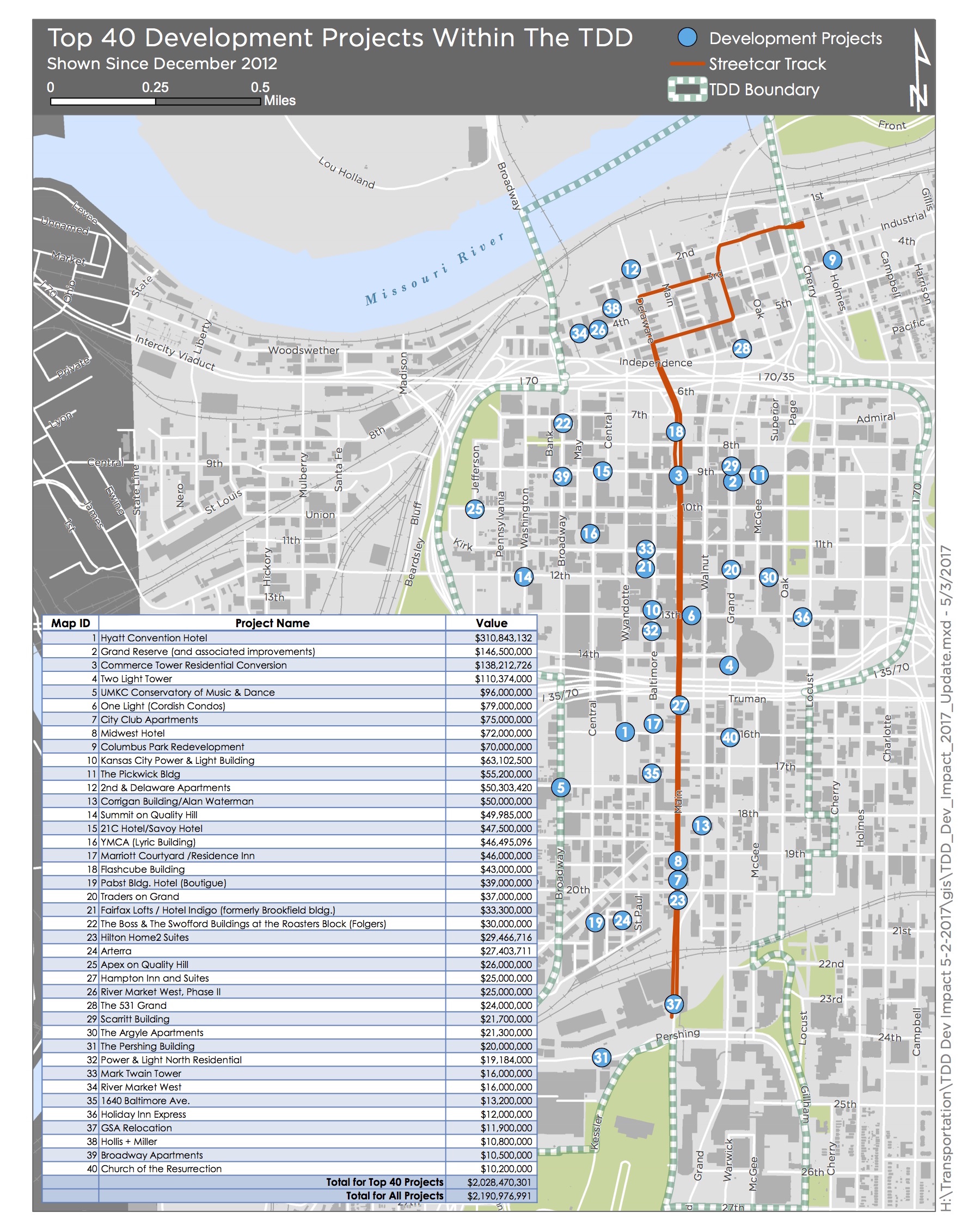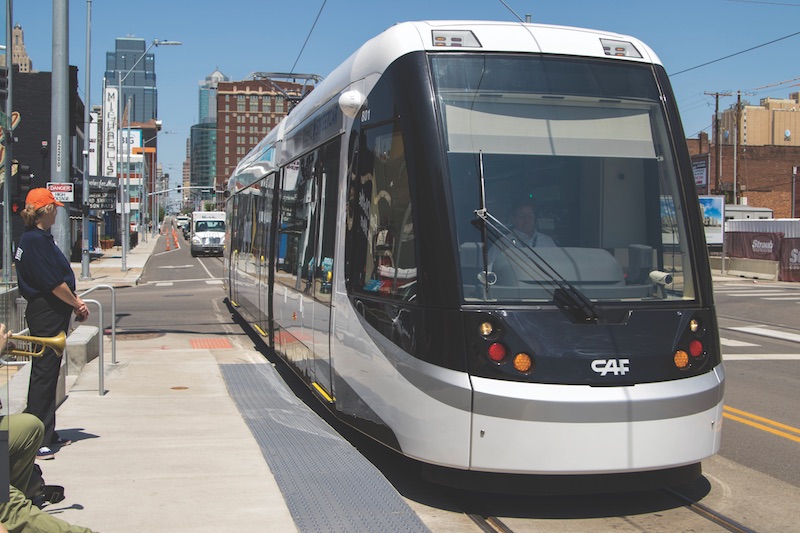Entertainment district developers agree that ample parking and mass transit give entertainment districts an edge that can make or break a venue.
The newly opened Irving Music Factory in Texas struck an agreement with a nearby shopping plaza that gives the district access to 2,500 of the plaza’s 2,700 parking spaces after 5 p.m. There are also plans to extend the Dallas Area Rapid Transit Orange Line—which goes out to DFW airport—to include a station near the entertainment district.
“We believe this is going to emerge as a multi-region destination,” predicts Barry Hand, Principal and Studio Leader with Gensler, which designed the entertainment district.
Kansas City’s recent downtown economic boom can be attributed in part to KC Streetcar, a 2.2-mile light-rail system that opened in May 2016, and connects downtown’s north and south quadrants.
 This map pinpoints more than $2 billion in real estate development. Courtesy CBRE.
This map pinpoints more than $2 billion in real estate development. Courtesy CBRE.
In Los Angeles, the entertainment district L.A. Live, whose parking is woefully inadequate, is expected to benefit from the proposed expansion of the city’s mass transit system. The Blue Line, which connects downtown L.A. to Long Beach, would be linked with the Gold Line, which runs out to Pasadena. The city also passed a sales tax to extend the system’s Red Line to Beverly Hills.
The proposed University City district in Charlotte, N.C., would be about a quarter-mile from one of the new station stops of the city’s light-rail system that’s being expanded.
“University City is exciting because of the impact of light rail and its development opportunities,” says Ashley Clark, Associate AIA, LEED AP, Director of Strategic Development and Communications with Land Design, an AE firm working on the project.
The district would be close to UNC Charlotte and the city’s Research Park. “The vision is for the entertainment district to provide a sense of place, with the transit as its gateway,” says Clark.
Related Stories
| Aug 11, 2010
Outdated office tower becomes Nashville's newest boutique hotel
A 1960s office tower in Nashville, Tenn., has been converted into a 248-room, four-star boutique hotel. Designed by Earl Swensson Associates, with PowerStrip Studio as interior designer, the newly converted Hutton Hotel features 54 suites, two penthouse apartments, 13,600 sf of meeting space, and seven "cardio" rooms.
| Aug 11, 2010
Aloft hotel opens at Washington National Harbor
A partnership of five developers, including the John Hardy Group and Peterson Companies, have completed a 190-room aloft hotel at Washington National Harbor, a mixed-use retail/entertainment development in Oxon Hill, Md., near Washington, D.C. Designed in conjunction with David Rockwell and the Rockwell Group, the aloft prototype offers atmospheric public spaces designed to draw guests from the...
| Aug 11, 2010
Manhattan's latest boutique hotel will be LEED Silver certified
New York-based developer Tribeca Associates has commissioned Brennan Beer Gorman Architects to design its latest mixed-use office and boutique hotel at 330 Hudson Street. Located in the downtown Hudson Square area of Manhattan, the LEED-Silver development will involve the redevelopment of a historic, eight-story warehouse building into 292,000 sf of office space, 15,000 sf of retail space, and ...
| Aug 11, 2010
Luxury Hotel required faceted design
Goettsch Partners, Chicago, designed a new five-star, 214-room hotel for the King Abdullah Financial District (KAFD) in Riyadh, Saudi Arabia. The design-build project, with Saudi Oger Ltd. as contractor and Rayadah Investment Co. as developer, has a three-story podium supporting a 17-story glass tower with a nine-story opening that allows light to penetrate the mass of the building.
| Aug 11, 2010
Westin Hotel
Mid-twentieth-century projects are in a state of limbo. In many cities, safeguards against quick demolition don't even cover “new” buildings built after 1939, yet many such buildings may be obsolete by current standards. The Farmers and Mechanics Savings Bank, located in downtown Minneapolis, was one such building, a rare example of architecture from a time when American design was ...
| Aug 11, 2010
Platinum Award: Monumentally Hip Hotel Conversion
At one time the tallest building west of the Mississippi, the Foshay Tower has stood proudly on the Minneapolis skyline since 1929. Built by Wilbur Foshay as a tribute to the Washington Monument, the 30-story obelisk served as an office building—and cultural icon—for more than 70 years before the Ryan Companies and co-developer RWB Holdings partnered with Starwood Hotels & Resor...
| Aug 11, 2010
Hilton President Hotel
Once an elegant and fashionably trendy locale, the Presidential Hotel played host to the 1928 Republican National Convention where Herbert Hoover was nominated for President, and acted as a hot spot for Kansas City Jazz in the '30s and '40s. The hotel was eventually abandoned in 1984, at which point it became a haven for vagabonds and pigeons, collecting animal waste and incurring significant s...
| Aug 11, 2010
CityCenter Takes Experience Design To New Heights
It's early June, in Las Vegas, which means it's very hot, and I am coming to the end of a hardhat tour of the $9.2 billion CityCenter development, a tour that began in the air-conditioned comfort of the project's immense sales center just off the famed Las Vegas Strip and ended on a rooftop overlooking the largest privately funded development in the U.
| Aug 11, 2010
Gold Award: Westin Book Cadillac Hotel & Condominiums Detroit, Mich.
“From eyesore to icon.” That's how Reconstruction Awards judge K. Nam Shiu so concisely described the restoration effort that turned the decimated Book Cadillac Hotel into a modern hotel and condo development. The tallest hotel in the world when it opened in 1924, the 32-story Renaissance Revival structure was revered as a jewel in the then-bustling Motor City.







